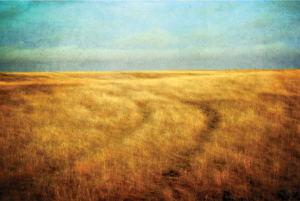Frank Grisdale フランク・グリスデール
|
Perhaps the best art makes you both appreciate and forget the medium being used. Canadian photographer Frank Grisdale certainly achieves this much in his work. He also challenges the boundaries between photography and painting with a photographic style and post- production methods that seem to turn photographs, literally, into a canvas. There is texture and apparent brush strokes. Light works in uncanny ways. Movement is captured, impressionistically. Grisdale shot briefly late in his teens while traveling the world for a few months. Although self-taught, he landed a photography assignment in Lesotho, Africa, where the landscapes became his muse and his subject. He then abandoned photography until he was 45. Why landscapes at this late date? Why photography? And how came this unique style? Koe: Photographers like Ansel Adams turned landscape photography into art of a high order, but these days it seems clichéd for the most part. Why did you choose this genre? Frank Grisdale: The greatest joy in life comes from being all you can be, which is a whopper of a cliché, but clichés are well worn because they resonate truth. I knew I had to develop an unrelenting focus and stay with it for a very long time in order to be successful. It’s the 10,000-hour rule. Put in that amount of time and you can’t help but become very good, even world class at whatever it is you are doing. So I knew when I decided to pursue photography for the last half of my productive life that I had to choose a genre that I could ‘live with’ for a long stretch. And getting up ridiculously early and being out there in the perfect setting at just the right time was something I knew I could do, consistently, over time. I had been doing it naturally since I was a kid working at our family farm in the summers. Being forced out of bed so regularly and so early by my father to go check the cattle with him imbedded the glory of early morning light in my brain. K: How do you avoid cliché and sentimentalism? FG: There was a long period of time between when I was deep into photography during university and my re-start in photography when I turned 45. So even though I didn’t have a camera with me for that 20 year period, I was constantly thinking about photography, reading about it and framing scenes in my head, just because I enjoyed visualizing imagery and viewing images. I bought every book published about photography worth buying. So by the time I started shooting seriously I had a very strong foundation of knowledge about what had been done. Like everyone though, in the first period of developing my work, I had to shoot what others had shot before me—a la Ansel Adams—just to get it out of my system and of course just to get technically proficient by shooting a lot. But I quickly found that shooting what I knew had been done before was unrewarding, uninspiring, and the only people who thought it was great stuff were people who didn’t know much about photography’s history and were seeing something new in what I knew was old. So the challenge for me after getting my chops down was to shoot landscape the way I had been seeing it in my mind all those years when I was not carrying a camera. Those mind shots are impressionistic, like all day dreams, so I began to try to shoot images that recalled that zen-like state of mind. I hadn’t seen anyone doing that kind of imagery in all my reading so I guess that is how I managed to avoid cliché and sentimentalism—by trying hard to shoot in a style and with a feel that I hadn’t seen in any of the hundreds of books and magazines that I had studied. K: Your pictures share some qualities with abstract impressionism. Was this conscious or simply a result of your technique? FG: I can’t say I set out with a goal to be an impressionist. I do recall thinking early on that the detail of an Ansel Adams shot was boring to me—almost too technically perfect to be interesting. That kind of work is the goal of most landscape photographers, so the number of competing images is ridiculous, and they all end up looking like each other. I wanted to be able to enter a landscape with a different goal—that of interpretation rather than duplication. K: How have painters and their techniques informed your work? FG: Obviously I like color so the Rothko’s fields of color appeal to me, as does the atmosphere of William Turner. For photographers I should mention that I think the work of Ernst Haas and his motion photography stuck in my head for a long time, as did the intimate nature studies of Eliot Porter. Today I am stunned and inspired by the work of Jack Spencer. K: Are there any Japanese photographers, or landscape artists, for that matter, whom you admire? FG: Hiroshi Sugimoto’s legendary seascapes are captivating. Yukikazu Ito has a similar aesthetic but a bit more eerie. He’s an emerging talent. In his ripe middle-age, it seems Frank Grisdale, too, is an emerging talent. His work is available from a number of international galleries. For more information, please refer to his website: www.frankgrisdale.com |
素晴らしいアートはその表現に使われている手段や媒体の存在を忘れさせる。カナダ出身の写真家フランク・グリスデールの作品はまさにその域に達している。彼は写真という手段を使いながら、撮影後の編集によって写真を絵画的に演出し、まさに絵画と写真の境界線に挑んでいる。彼の作品には絵画的質感があり、筆のはけ筋さえも見えるような演出もなされている。光の使い方も絶妙だ。印象派の絵画のごとく「動き」も見事に表現されている。 彼は10代の終わり頃に何カ月か海外旅行に出て、その時に何枚かの写真を撮っている。独学ではあったが、アフリカのレソトで写真関係の仕事をし、そこで風景写真の魅力を知った。その後彼はいったん写真を離れたが、45歳になって再びカメラを手にした。 なぜ今さら風景写真にこだわるのか。彼のユニークな作風は如何にして生まれたのか。 Koe:アンセル・アダムスなどの写真家の功績によって風景写真というジャンルは高次元のアートとして認知されましたが、現在では特に目新しい分野という感じはありませんよね。敢えてそのような分野に取り組もうと思ったのはなぜですか? フランク・グリスデール:自分の可能性を試すことから人生の喜びが生まれます。「可能性を試す」という言葉は使い古されたものですが、それが真実を映し出すからこそ皆可能性を試す努力を繰り返すわけです。私は、何かを成功させるためには継続してしかも集中してそれに取り組まなければいけないことを知っていました。これは「1万時間の法則」と呼ばれているものです。1万時間、実践と努力を続ければどんな分野でも成功できる、という法則です。残りの人生を写真家として実りあるものにしようと決心した時に選んだ風景写真というジャンルは長く付き合えるものでなければならなかったわけです。夜の明けぬうちから起きだして目的地に着いたら完璧にセッティングを済ませてシャッターチャンスを待つ。これは僕にとっては難しいことではありませんでした。小さい頃から夏になると家族と農場で働いてきましたから。毎朝決まった時間、しかも早い時間に起こされ、父親と一緒に畜牛の様子を見に行くのが日課で、その記憶が体に染みついていたのです。 K:あなたの作品が感傷主義的にならず、非凡なのはなぜでしょう? フ:大学時代に一度写真にのめり込んだ時から45歳になって再び写真に取り組み始めた時まで随分間がありました。カメラを手にしていなかった20年の間も写真のことはずっと頭にあって、写真関連の書物を読んだり、頭の中でイメージを思い描いたりしていました。写真関連でこれはと思う本は全て買って読んでいましたから本格的に写真を撮るようになった時点ですでに、過去にどのような作品が撮られてきたかよく知っていました。それでも最初のうちはアンセル・アダムス風の写真や、過去の誰かの作品に似たような写真をたくさん撮りました。たくさん撮ることで技術的に上達しますから。しかし何々風な作品を撮り続けることはやりがいが無い上に退屈でした。そして、そのようなありきたりな写真を撮り続けている写真家たちは過去に発表された作品についてあまり勉強していない、ということに気付くのに時間はかかりませんでした。 技術的にある程度上達したら次にやるべきことは、空白の20年間に頭の中でイメージを思い描いていたのと同じように実際の風景を撮っていく、ということでした。そして私は「禅」を連想させるようなイメージで写真を撮り始めました。たくさんの写真関連の本を読みましたが、そのような発想でイメージを作品にしている写真家は過去に誰もいませんでした。 K: あなたの作品には抽象的印象主義の影響も見られますがそれは意識的なものですか? フ:自分では印象派だとは思っていません。アンセル・アダムスの作品は技術的に完璧なあまり逆に興味をそそられません。しかしそのような作品が多くの風景写真家の目指すところであることも事実で、結果的にどの作品も似たり寄ったりのものになってしまっています。僕は風景写真を写実的に撮ることを考えていません。僕の解釈による要素を盛り込みたいと思っています。 K: 画家や絵画的手法からの影響はありますか? フ:マーク・ロスコの色彩感覚やウィリアム・ターナーの作風には影響を受けました。写真家では、「ブレ」「動き」などの手法を用いたエルンスト・ハースや、自然科学に造詣が深かったエリオット・ポーターの作品が好きでした。最近ではジャック・スペンサーの作品に大いに刺激を受けています。 K: 日本人で好きな写真家はいますか? フ:杉本博司による「海景」のシリーズは素晴らしいと思います。伊藤之一も同様の美学を持っていますが少し不気味さも感じるユニークな作風ですね。新しい才能を感じます。 中年にさしかかったフランク・グリスデール自身も新しい才能を感じさせる。彼の作品は海外のギャラリーを通じて購入可能。詳しくは彼のウェブサイトを参照のこと。 www.frankgrisdale.com |










[…] for the fall photo contest , Frank Grisdale, is featured in Koe Magazine – see the interview here ©Frank […]